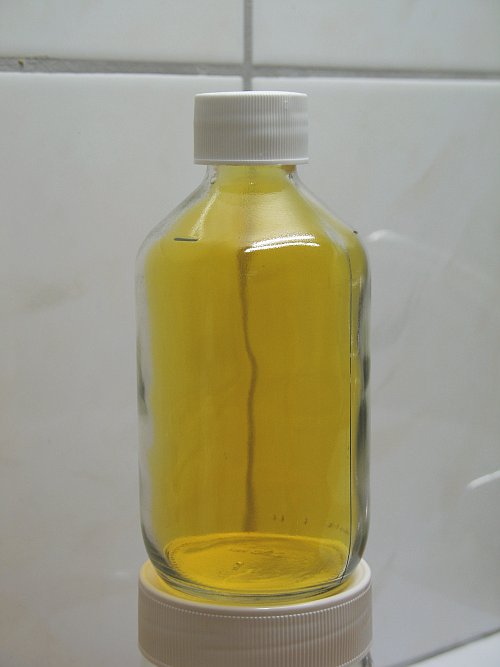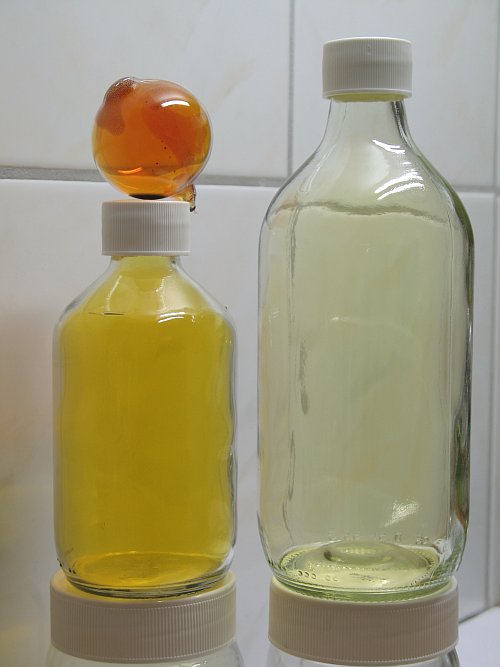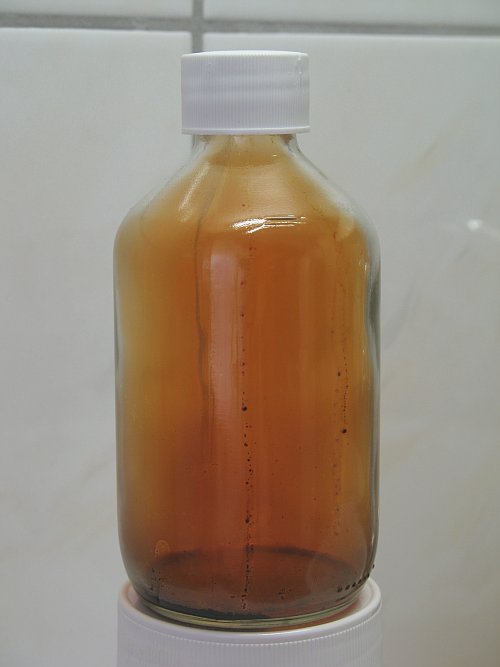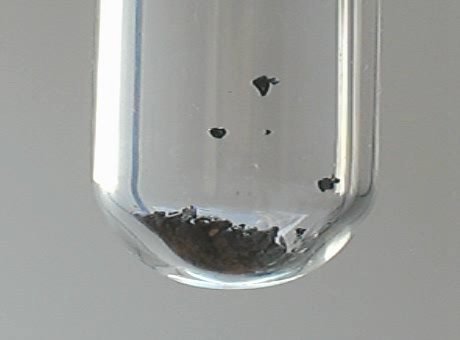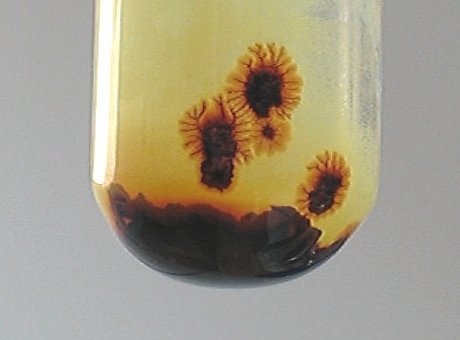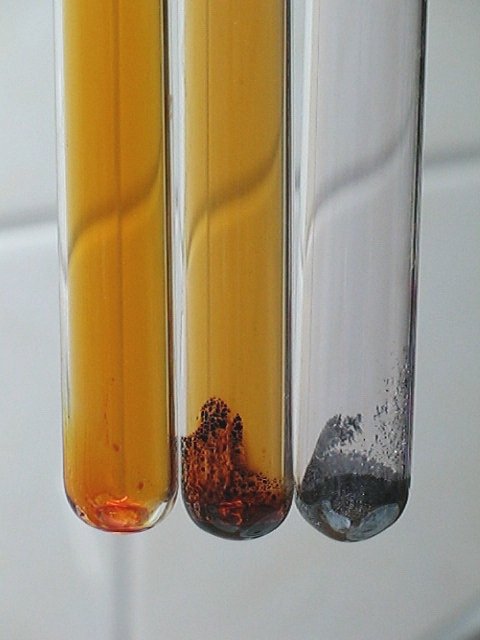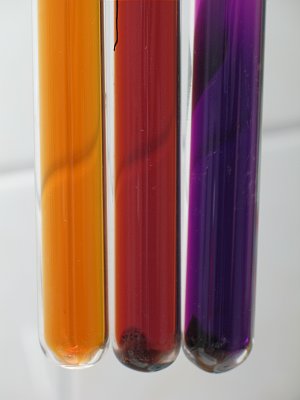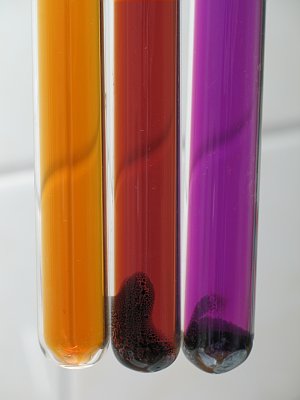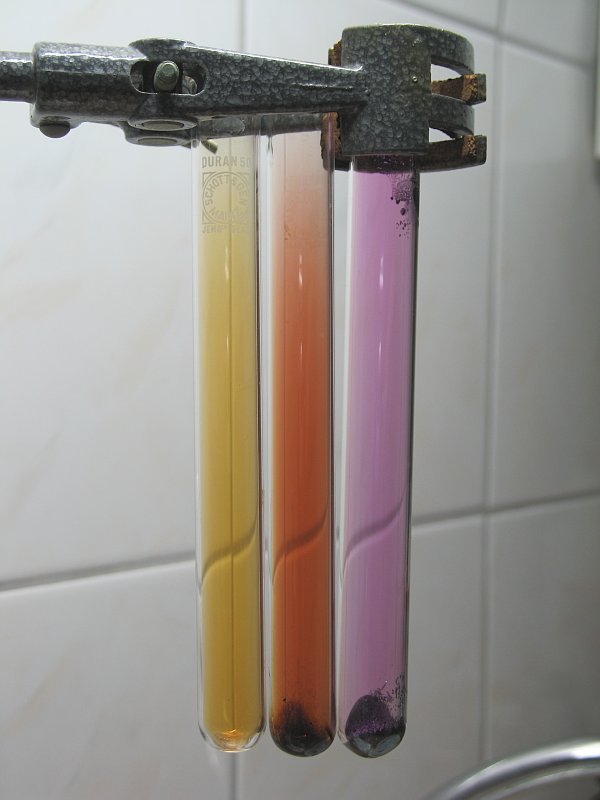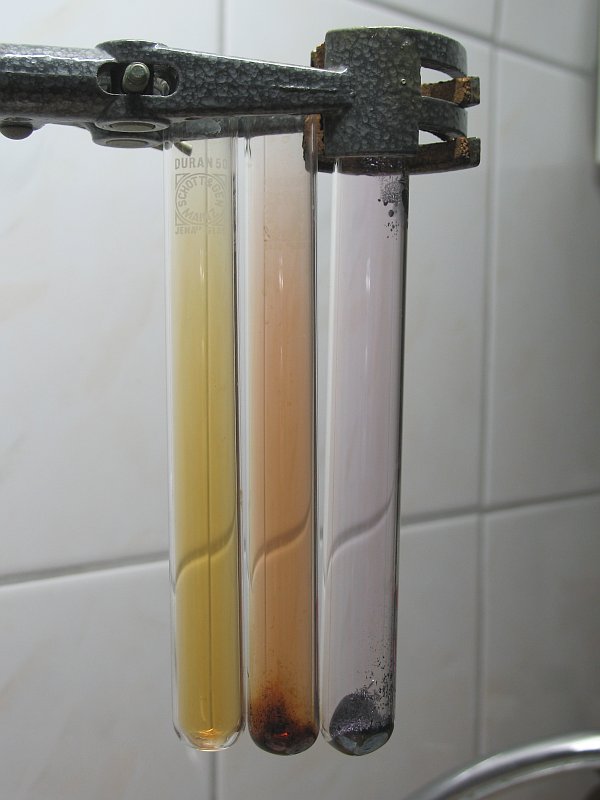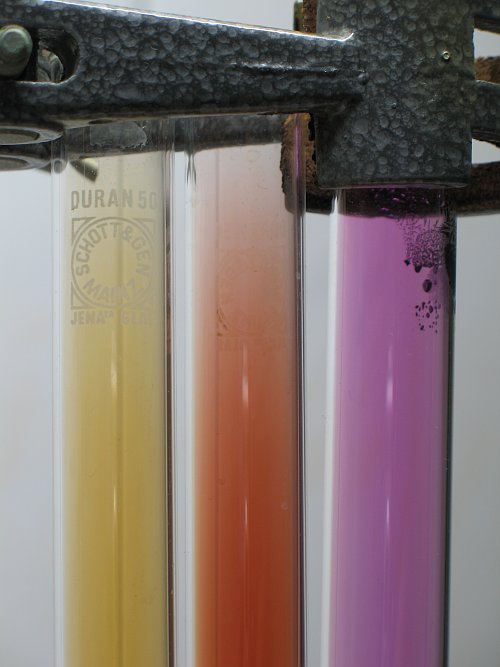|
The halogens, colored gaseous compounds It is well-known that the halogens are colored low-boiling compounds, with colors, which are increasingly strong when going from fluorine to iodine. Interesting though is the color of interhalogen compounds. These also have interesting colors in the vapor phase. When one is confined to the halogens Cl, Br and I, then the following interhalogens are possible: BrCl, ICl, ICl3, IBr. Making these interhalogens from the parent halogens is easy. The parent halogens simply need to be mixed and then the interhalogen compounds are formed in equilibrium reactions. For BrCl, ICl and IBr the equilibrium is far to the side of the interhalogen compound. At room temperature, liquid ICl contains only 0.4% as parent halogens. Liquid IBr, just above room temperature, contains approximately 10% of its weight as parent halogens. Gaseous BrCl contains some free parent halogens as well, but the compound is sufficiently stable to determine its boiling point. ICl3 is in equilibrium with ICl and Cl2. This compound only can exist in an atmosphere of almost pure Cl2. At lower concentrations of chlorine, the compound quickly looses chlorine (matter of tens of seconds). BrCl is a gaseous compound at room temperature, it has a golden yellow/orange color and it boils at +5 ºC. ICl is a dark brown liquid/solid at room temperature, which melts at 27 ºC and boils at 97 ºC, with a brown vapor. IBr is a dark red solid, which melts at 41 ºC and boils at 116 ºC, with a very dark red vapor. At higher dilution the color of its vapor is brick red. ICl3 is a yellow solid, which cannot be evaporated. On heating it decomposes to ICl and Cl2. Only in a high pressure atmosphere of chlorine (16 atm), it can be melted at 101 ºC. The information about stabilities, melting points and boiling points, is from the following book: Greenwood, N. N.; Earnshaw, A. (1997). Chemistry of the Elements, 2nd Edition. ISBN 0-7506-3365-4, pages 825 and 828. The information on colors, however, only very roughly matches the experimental outcomes, shown below. The colors are actually more interesting than what one would conclude from the book.
Making of bromine chloride This can easily be made by adding bromine to a bottle, filled with chlorine. For this experiment, a bottle of 250 ml (when filled completely, almost 300 ml) is filled completely with dry chlorine gas. This dry chlorine gas is made from swimming pool chlorine tablets and some dilute hydrochloric acid, with the gas being lead through a long cold glass tube to condense most of the water on the glass. To this bottle of chlorine gas, approximately 0.5 ml of liquid bromine is added, which is approximately 70% of the theoretical amount of bromine needed. After adding the bromine, the bottle is capped immediately with a cap having a teflon liner. When the bromine is added, then it is amazing to see how quickly the bromine seems to evaporate. In reality, it reacts with the chlorine to form BrCl, which is gaseous at room temperature. Within just a few seconds, all bromine is gone and has reacted with the chlorine. The gas mix in the bottle becomes pressurized. This is because the addition of bromine results in a large amount of additional gas to be produced. Each molecule of chlorine that reacts with bromine leads to two molecules of BrCl. The picture below shows a bottle with gaseous bromine chloride, with some excess chlorine, the excess pressure being released. The color of this compound is much lighter than the color of an equivalent amount of bromine vapor, it is golden yellow, instead of red/brown.
It is very instructive to have all three compounds Cl2, BrCl and Br2 together in one picture. The contrast between the colors of the three compounds is rather large. The picture below shows a sphere, filled with some bromine vapor and approximately 0.5 ml of liquid bromine in it, the bottle with the BrCl-gas, and a bottle of 500 ml with almost pure Cl2. The picture also shows that bromine has a darker color: the sphere has a much smaller diameter than the bottle, but still it has a darker color. Chlorine by far has the weakest color. Although the biggest bottle is used for pure chlorine, its color still is only weak.
The gas BrCl is a very dense gas, when compared to the density of air. In the following video, it is shown how this gas can be poured from its bottle: pouring of BrCl (download size approximately 2 MByte).
Making of iodine chloride There only is one bromine chloride, but two different iodine chlorides are known. One of them is iodine monochloride, which is a very dark brown solid/liquid, and the other is a yellow solid, a very unstable compound, iodine trichloride, which only can be kept in an atmosphere of chlorine. Iodine monochloride can be made by keeping iodine under an atmosphere of chlorine for some time. The solid then absorbs chlorine and liquefies, forming ICl. When it is kept under chlorine for a longer time, then the yellow solid ICl3 is formed. When the chlorine atmosphere is removed, then the ICl3 decomposes to ICl and Cl2. In this experiment, some liquid ICl is transferred to a bottle, and this bottle is heated under a hot running tap in order to get a decent concentration of vapor of ICl. The picture below shows the bottle with ICl-vapor, and liquid ICl on the bottom, and still some liquid ICl at the glass wall.
The color of vapor of ICl resembles the color of bromine vapor very much. The compound, however, is somewhat less volatile than bromine, and the color is a little bit more brown instead of red/brown. This resemblance of ICl to Br2 has mislead the first discoverer of bromine. He thought that his compound was ICl. The formation of ICl and ICl3 is quite interesting in its own. It was made by putting some iodine in a thick test tube and keeping the large bottle with 500 ml of chlorine gas (see experiment above) upside down above the test tube. The pictures below show the initial amount of iodine (with also some little pieces sticking to the glass) and the situation, after keeping the bottle with chlorine above the test tube for some time:
It is very interesting to see the formation of the dendrite-shaped 'tentacles'. The yellow compound, sticking on the glass is ICl3, the dark liquid is ICl. The formation of the ICl and ICl3 is shown in a video as well: IClx.avi (download size approximately 1.9 MByte). Another nice experiment with ICl and ICl3, which shows more properties of these compounds is available here.
Making of iodine bromide For this experiment, three test tubes were used, one is filled with bromine (200 mg), the other is filled with a mix of excess bromine and iodine in an appr. 1.5 : 1 molar ratio (200 mg + 200 mg), and the last one is filled with iodine (300 mg). The test tube with iodine and bromine first is heated carefully, in order to mix the compounds and get a liquid, from which excess bromine easily is driven off. Then the test tubes are allowed to cool down again and that results in the following starting situation:
The left test tube contains some left over liquid bromine and its vapor. The middle test tube contains solid iodine bromide and bromine vapor from the excess bromine (carefully driven off by the slight heating). The right test tube contains solid iodine. Next, all three test tubes are heated much more strongly. This results in very vigorous boiling of the iodine bromide, and slower boiling of the iodine, although the heating of this was even slightly stronger. The result of the heating is shown in the following video: heating of iodine and its bromide (download size appr. 3.5 MByte). After this strong heating, the test tubes are allowed to cool down again. Now one can nicely see the colors of the different vapors, just a few seconds after heating and approximately 30 seconds later. The left is bromine, the middle is iodine bromide, and the right is iodine.
After a longer time of cooling down, the vapors in the test tubes have soft, but beautiful colors:
When the test tubes are allowed to cool down to room temperature, then they look as follows.
Iodine bromide still has quite some visible vapor at room temperature. The color of this vapor is distinct from the color of bromine. Iodine hardly has any visible vapor at room temperature. When one really looks carefully at the test tube with iodine, then a faint purple color can be observed. The color of the bromine vapor has become so weak, because most of the vapor has diffused out of the test tube. A closeup of the vapors of the three test tubes, when they are still luke-warm is given in the picture below. The contrast of the vapor colors is very nice.
|
|
|
|
|
|
|
|
|
|
|



